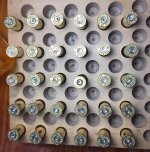I know the possible issues this kind of a primer strike can be but has anyone ever seen a revolver that hits the primer like this? That was normal?
Personally I wouldn't shoot it till I had it checked. Which for a timing issue could be done in seconds with a rod of some kind.
I was just given >400 38 special cases. Federal once fired and every one, every single one has the same indention on the primer. The case itself looks normal with no bulges or strange markings.
I don't know the gun but after seeing them I sent an e mail out to the owner on what kind of gun it is.
Personally I wouldn't shoot it till I had it checked. Which for a timing issue could be done in seconds with a rod of some kind.
I was just given >400 38 special cases. Federal once fired and every one, every single one has the same indention on the primer. The case itself looks normal with no bulges or strange markings.
I don't know the gun but after seeing them I sent an e mail out to the owner on what kind of gun it is.


